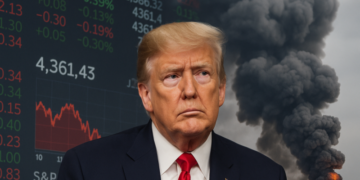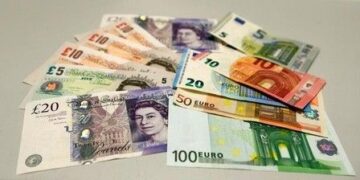The Fed Waits Out the Tariff Economy; Bank of England Mirrors Fed and Stands Pat By Roshan Fernandez
The Bank of England held interest rates steady Thursday, a day after the Federal Reserve made the same decision. But Bank of England Gov. Andrew Bailey said rates are on a gradual downward path even though the bank held them steady this time. “The world is highly unpredictable,” he said. A day earlier, Fed officials left the door open to cutting interest rates in the second half of the year but indicated they were in no hurry to do so. Several other central banks made policy decisions as well, with Switzerland’s and Norway’s cutting rates and Brazil’s raising them.
Top News The Fed Waits Out the Tariff Economy
Federal Reserve Chair Jerome Powell projected confidence when he insisted the central bank was in a good position to handle whatever the economy does next-all while repeatedly acknowledging the Fed has little idea what’s actually coming.
The Fed is trying to see how the dust will settle from the aftereffects of President Trump’s April 2 “Liberation Day” tariff announcements, among other policy changes. Most economists expect tariffs to lift prices over the coming months, and that is a worry for the Fed because officials still don’t feel as if they completely vanquished inflation after a three-year-long fight.
Fed Holds Rates Steady and Keeps Door Open to Cuts Transcript: Jerome Powell’s Postmeeting Press Conference Fed Statement Tracker Bank of England Mirrors Fed and Stands Pat
The Bank of England left its key interest rate unchanged , mirroring the Federal Reserve’s decision a day earlier, as policymakers face a rise in oil prices that could push inflation further above their target.
Swiss Central Bank Cuts Interest Rate to Deter Search for Safe Haven
Switzerland’s central bank cut interest rates to zero as it hopes to rein in the rapidly appreciating franc, which has acted as a safe haven for investors given raised concerns over U.S. trade policy and Middle East tensions.
Norges Bank Surprises With Rate Cut and Hints at Further Easing Brazil’s Central Bank Extends Hiking, Indicates Potential Pause Turkish Central Bank Stands Pat on Rates Despite Easing Inflation China’s Central Bank Seeks Bigger Role for Yuan on Global Stage Philippines Central Bank Cuts Rates to Boost Economy Taiwan Central Bank Stays on Hold Again as Uncertainty Persists ECB’s Next Move Most Likely to Be a Rate Cut, Villeroy Says Irish Central Bank Warns U.S. Policy Changes Could Lead to Slower Growth, Higher Debt U.S. Economy The Path to Record Deficits
Take a spin in the time machine, back to an era when the federal budget deficit didn’t look like a problem at all.
In 2000, the federal government actually ran a surplus and the Congressional Budget Office, Capitol Hill’s nonpartisan scorekeeper, projected the Treasury would keep collecting enough revenue to pay for all government programs and generate continuing surpluses.
Fast-forward to 2025, and the U.S. is running record deficits outside of wars, recessions or crises. The nation’s publicly held debt is nearing 100% of gross domestic product and is projected to surpass the post World War II record of 106% in a few years. What happened?
The Biggest Companies Across America Are Cutting Their Workforces
Corporate America is convinced: Fewer employees means faster growth. U.S. public companies have reduced their white-collar workforces by a collective 3.5% over the past three years, according to employment data-provider Live Data Technologies. Over the past decade, one in five companies in the S&P 500 have shrunk.
Financial Regulation Stablecoin Legislation Will Juice Demand for Treasurys-to a Point
New legislation regulating stablecoins-a type of digital currency pegged to the U.S. dollar-is widely expected to boost demand for Treasurys. But Wall Street isn’t sure how much .
Switzerland’s New Capital Rules Will Be Feasible for UBS, SNB Says
Switzerland’s proposal to introduce tougher capital requirements on UBS Group will be feasible for the banking giant and shouldn’t excessively reduce its shareholder distributions, the country’s central bank said.
Commentary War Brings Out the Best in the Dollar
The dollar is finally behaving as it should, after six months when its haven status was undermined and usual economic relationships broke down. This could be a sign that its terrible run of weakness is nearing an end, writes James Mackintosh for The Wall Street Journal .
Israel’s attack on Iran tested the dollar’s status amid a flight to safety. The greenback passed: The ICE U.S. Dollar index is up about 1% since the first bombing. More important, the currency behaved as it should, rising on days dominated by fear and falling on days when fear receded.
Investors who worried that international money would no longer flow to the U.S. in times of crisis can breathe a sigh of relief. So long as the dollar rises in bad times, it provides a hedge against serious trouble, making it more attractive.
There are other reasons to think that after the sharp drop in the dollar this year-even after this week’s bounce, it is still down 10% from its January high-it may be ready for a breather.
It’s become a crowded trade. Everyone I speak to outside the U.S. is less enamored of the country than they used to be.
Forward Guidance Friday (all times ET)
8:30 a.m.: Philadelphia Fed Business Outlook Survey
10 a.m.: Leading Indicators
4:30 p.m.: Foreign Central Bank Holdings
4:30 p.m.: Federal Discount Window Borrowings
Monday
9:45 a.m.: U.S. Flash Manufacturing PMI
9:45 a.m.: U.S. Flash Services PMI
10 a.m: Existing Home Sales
1:15 p.m.: Federal Reserve Bank of Chicago President Austan Goolsbee speaks at Milwaukee Business Journal Mid-Year Outlook event
2:30 p.m.: FRB New York President John Williams and Federal Reserve Governor Adriana Kugler speak at Fed Listens roundtable discussion
Basis Points Almost a third of the eurozone’s goods trade surplus with the U.S. is accounted for by sales of products manufactured by the affiliates of American businesses, which also account for most of the eurozone’s deficit in the trade in services, the European Central Bank said Friday. British shoppers drew back on spending, a new sign of pessimism in an economy struggling to gain momentum. Retail sales volumes were 2.7% lower on month in May, the country’s Office for National Statistics said Friday. The mood among British consumers improved a little this month , though global turmoil could see confidence darken again ahead. Consumer confidence improved two points to minus 18, according to research group GfK’s monthly index for June Australia’s unemployment rate remained around its lowest levels in half a century in May, but the latest data contained some hints that the job market could slow in the coming months. New Zealand’s economy grew more than expected in the first quarter as falling interest rates helped lift the country out of an extended downturn, but fresh headwinds are gathering. China’s exports of rare-earth magnets plummeted after it imposed controls on their overseas sale, emphasizing Beijing’s dominance of a critical input into electric vehicles and jet fighters that has taken center stage in tensions with the U.S. Japan’s consumer inflation gathered pace in May , but that may not bring a rate hike closer, as the Bank of Japan waits to see how U.S. trade talks unfold. Japan’s Ministry of Finance plans to reduce its issuance of superlong Japanese government bonds, after a rapid rise in long-end yields alarmed markets. Bank of Canada officials are tracking labor-market conditions to determine whether job cuts in trade-exposed sectors like manufacturing start spreading in other parts of the economy, Gov. Tiff Macklem said Wednesday. Macklem also said it is possible the central bank’s preferred gauges of core inflation might be overstating how much prices are rising. Canada unveiled on Thursday policies to support the domestic steel sector , including a curb on imports. The sector faces financial duress due to President Trump’s hefty 50% tariffs on the metal. Overseas investment by businesses around the world is at risk of falling for a third straight year as rising tariffs and geopolitical tensions freeze big decisions about where to locate factories, the United Nations warned. Executive Insights
Here is our weekly roundup of stories from across WSJ Pro that we think you’ll find useful.
An Austin startup has gotten U.S. clearance to build a “guideway” on which autonomous hybrid shuttles would ferry freight between Mexico and Texas in an effort to speed up trade. Private equity accounts for about half of the companies in the “shadow IPO pipeline,” setting the stage for what could be a busy second half of companies going public. An Israeli startup is rethinking how to tackle two of the planet’s most stubborn environmental threats-toxic algae that can lead to dead zones in oceans and rising carbon levels. The ad world is obsessed with industry news videos from two 27-year-old guys . About Us
WSJ Pro Central Banking brings you central banking news, analysis and insights from WSJ’s global team of reporters and editors. This newsletter was compiled by news associates Roshan Fernandez in New York. Send your tips, suggestions and feedback to r [email protected] .
This article is a text version of a Wall Street Journal newsletter published earlier today.
(END) Dow Jones Newswires
06-20-25 0716ET

















